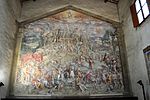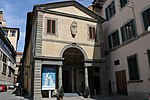Pistoia Brazilian war cemetery
Brazil in World War IIModernist architecture in ItalyPistoiaVargas EraWorld War II cemeteries ... and 2 more
World War II cemeteries in ItalyWorld War II memorials in Italy

The Pistoia Brazilian war cemetery is a former Second World War cemetery located in Pistoia, Toscana, Italy. The cemetery site honors Brazilian soldiers who died in Italy during World War II, the remains of whom were buried here until 1960.
Excerpt from the Wikipedia article Pistoia Brazilian war cemetery (License: CC BY-SA 3.0, Authors, Images).Pistoia Brazilian war cemetery
Via Priora, Pistoia
Geographical coordinates (GPS) Address Nearby Places Show on map
Geographical coordinates (GPS)
| Latitude | Longitude |
|---|---|
| N 43.945 ° | E 10.943 ° |
Address
Monumento votivo militare brasiliano (Brazilian Expeditionary Force)
Via Priora
51100 Pistoia
Tuscany, Italy
Open on Google Maps









